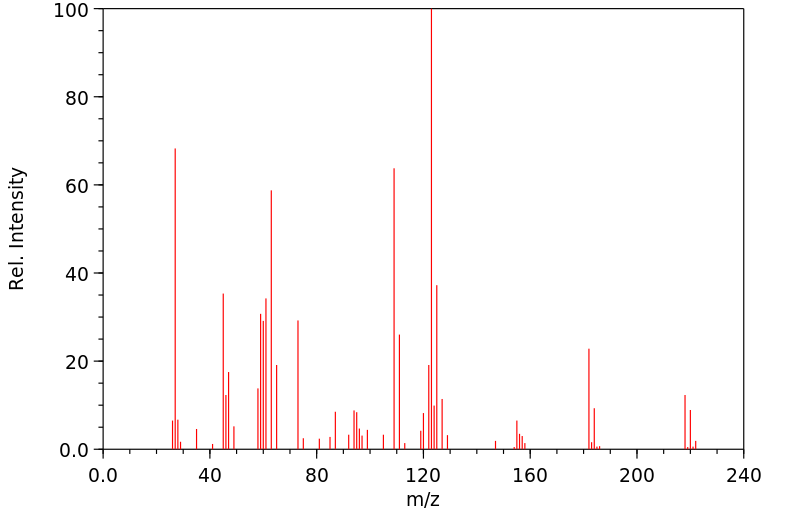1,2-二乙烷 | 3563-36-8
-
物化性质
-
计算性质
-
ADMET
-
安全信息
-
SDS
-
制备方法与用途
-
上下游信息
-
文献信息
-
表征谱图
-
同类化合物
-
相关功能分类
-
相关结构分类
计算性质
-
辛醇/水分配系数(LogP):2.7
-
重原子数:10
-
可旋转键数:7
-
环数:0.0
-
sp3杂化的碳原子比例:1.0
-
拓扑面积:50.6
-
氢给体数:0
-
氢受体数:2
ADMET
上下游信息
-
上游原料
中文名称 英文名称 CAS号 化学式 分子量 芥子气 1-chloro-2-(2-chloroethylsulfanyl)ethane 505-60-2 C4H8Cl2S 159.08 -
下游产品
中文名称 英文名称 CAS号 化学式 分子量 —— 1-(2-chloroethylthio)-2-vinylthioethane 114811-36-8 C6H11ClS2 182.738 六硫环辛烷 1,4,7,10,13,16-hexathiacyclooctadecan 296-41-3 C12H24S6 360.719 1,4,7,10-四硫环十二烷 1,4,7,10-tetrathiacyclododecane 25423-56-7 C8H16S4 240.479 —— {1,4,7,10,13,16,19,22-octathiacyclotetracosane 133819-59-7 C16H32S8 480.958 —— 1,4,7,10,13,16,19-heptathiaheneicosane —— C14H28S7 420.838 —— 3,6-dithiaoctan-1,8-dithiol 25423-55-6 C6H14S4 214.441 —— 1,2-bis(2-methylthioethylthio)ethane 56977-04-9 C8H18S4 242.495
反应信息
-
作为反应物:描述:参考文献:名称:Synthesis and properties of the first series of mixed thioether/telluroether macrocycles摘要:本文介绍了通过 "变相稀释 "方法制备硫醚/四氢醚混合大环的第一个实例:[9]aneS2Te(1,4-二硫杂-7-碲基十四烷)、[11]aneS2Te(1,4-二硫杂-8-碲基十四烷)、[12]aneS2Te(1,5-二硫杂-9-碲基十四烷)和[14]aneS3Te(1、和[14]aneS3Te(1,4,7-三硫杂-11-碲基十四烷)的晶体结构,同时还描述了[Ag([11]aneS2Te)]BF4 的晶体结构。DOI:10.1039/b008370o
-
作为产物:描述:参考文献:名称:长链硫芥末降解过程中导致硫代二甘醇的意外反应途径摘要:用各种商业净化剂降解长链硫芥末,通过未报告的反应途径意外地形成了硫二甘醇(TDG)。化学战剂(CWA)降解产物必须与其参考化合物明确相关,才能实现国际验证协议。因此,使用水基去污剂形成TDG会导致该化学物质来源的不确定性,该不确定性已系统地用于明确证明环境和生物医学样品中存在钇铁矿。因此,这些新颖而空前的降解途径将导致出于法医目的对国际验证协议的修改,或者将TDG排除为堇青石的唯一标记。DOI:10.1021/acs.joc.8b01670
文献信息
-
Mass Spectral Studies on Vinylic Degradation Products of Sulfur Mustards under Gas Chromatography/Mass Spectrometry Conditions作者:L. Sai Sachin、R. Karthikraj、K. Kalyan Kumar、T. Sony、N. Prasada Raju、S. PrabhakarDOI:10.1255/ejms.1398日期:2015.12
Sulfur mustards are a class of vesicant chemical warfare agents that rapidly degrade in environmental samples. The most feasible degradation products of sulfur mustards are chloroethyl vinylic compounds and divinylic compounds, which are formed by the elimination of one and two HCl molecules from sulfur mustards, respectively. The detection and characterization of these degradation products in environmental samples are an important proof for the verification of sulfur mustard usage. In this study, we synthesized a set of sulfur mustard degradation products, i.e., divinylic compounds (1–7) and chloroethyl vinylic compounds (8–14), and characterized using gas chromatography/mass spectrometry (GC/MS) under electron ionization (EI) and chemical ionization (CI) (methane) conditions. The EI mass spectra of the studied compounds mainly included the fragment ions that resulted from homolytic cleavages with or without hydrogen migrations. The divinylic compounds (1–7) showed [M – SH]+ ions, whereas the chloroethylvinyl compounds (8–14) showed [M – Cl]+ and [M – CH2CH2Cl]+ ions. Methane/CI mass spectra showed [M + H]+ ions and provided molecular weight information. The GC retention index (RI) values were also calculated for the studied compounds. The EI and CI mass spectral data together with RI values are extremely useful for off-site analysis for the verification of the chemical weapons convention and also to participate in official Organization for the Prohibition of Chemical Weapons proficiency tests.
硫芥子是一类气泡剂化学战剂,它们在环境样品中迅速降解。硫芥子最可行的降解产物是氯乙基乙烯化合物和二乙烯化合物,它们分别通过从硫芥子中消除一个和两个HCl分子形成。在环境样品中检测和表征这些降解产物对于验证硫芥子的使用是重要的证据。在这项研究中,我们合成了一组硫芥子降解产物,即二乙烯化合物(1-7)和氯乙基乙烯化合物(8-14),并使用气相色谱/质谱联用(GC/MS)在电子电离(EI)和化学电离(CI)(甲烷)条件下进行表征。研究化合物的EI质谱主要包括由于有或无氢迁移而导致的自由裂解的碎片离子。二乙烯化合物(1-7)显示[M - SH]+离子,而氯乙基乙烯化合物(8-14)显示[M - Cl]+和[M - CH2CH2Cl]+离子。甲烷/CI质谱显示[M + H]+离子并提供分子量信息。还计算了研究化合物的GC保留指数(RI)值。EI和CI质谱数据以及RI值对于离线分析以验证化学武器公约以及参加官方禁化武组织的熟练测试非常有用。 -
[EN] VITAMIN D RECEPTOR MODULATORS<br/>[FR] MODULATEURS DE RECEPTEUR DE VITAMINE D申请人:LILLY CO ELI公开号:WO2004048309A1公开(公告)日:2004-06-10The present invention relates to novel, non-secosteroidal, diaryl compounds with vitamin D receptor (VDR) modulating activity that are less hypercalcemic than 1a,25 dihydroxy vitamin D3. These compounds are useful for treating bone disease and psoriasis.
-
THERMAL DEGRADATION OF BIS (2-CHLOROETHYL) SULFIDE (MUSTARD GAS)作者:George W. Wagner、Brian K. Maciver、Dennis K. Rohrbaugh、Yu-Chu YangDOI:10.1080/10426509908031618日期:1999.9.1Abstract The thermal degradation of mustard gas (ClCH2CH2SCH2CH2Cl, “HD”), with and without 5% added water, is examined. GC/MS, LC/MS and NMR were employed to comprehensively analyze the products. After 75 days at 90°C, 91% HD remains (80% with 5% water). After 40 days at 140°C, 30% HD remains (24% with 5% water) and black “tar” precipitates form. The apparent Ea is 22.4 kcal/mol. Major products include摘要 研究了芥子气(ClCH2CH2SCH2CH2Cl,“HD”)在添加和不添加 5% 水的情况下的热降解。采用GC/MS、LC/MS和NMR对产物进行综合分析。在 90°C 下 75 天后,仍有 91% 的 HD(80% 与 5% 的水)。在 140°C 下 40 天后,仍有 30% 的 HD(24% 与 5% 水)并形成黑色“焦油”沉淀物。表观 Ea 为 22.4 kcal/mol。主要产品包括Q(ClCH2CH2SCH2CH2SCH2Cl)、1,2-二氯乙烷、多硫化物和1,4-二噻烷。使用 5% 的水,会产生 1,4-噻烷和 2-氯乙醇等含氧化合物以及许多锍离子,包括 S-(2-氯乙基)-1,4-二噻鎓,这是“芥末脚跟”的主要成分。由于在这些温度下反应的平衡性质,分解不会完全。
-
Vesicant treatment with phenyl-phenyl type vitamin d receptor modulators申请人:Nagpal Sunil公开号:US20060094778A1公开(公告)日:2006-05-04The present invention relates to a method of treating or preventing damage to human skin cells by chemical vesicants by administering a non-secosteroidal, diphenyl compound with vitamin D receptor (VDR) modulating activity.
-
[EN] VITAMIN D RECEPTOR MODULATORS<br/>[FR] MODULATEURS DE RECEPTEUR DE LA VITAMINE D申请人:LILLY CO ELI公开号:WO2005051938A1公开(公告)日:2005-06-09The present invention relates to novel, non-secosteroidal, phenyl-benzofuran compounds with vitamin D receptor (VDR) modulating activity that are less hypercalcemic than 1α,25 dihydroxy vitamin D3. These compounds are useful for treating bone disease and psoriasis.
表征谱图
-
氢谱1HNMR
-
质谱MS
-
碳谱13CNMR
-
红外IR
-
拉曼Raman
-
峰位数据
-
峰位匹配
-
表征信息







